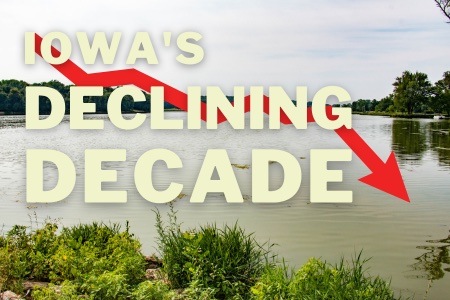Alicia Vasto is the Water Program Director with the Iowa Environmental Council. This piece was initially published in the organization’s Weekly Water Watch e-newsletter on June 2, 2023.
The Iowa Environmental Council launched a new website, decliningdecade.org, in late May to mark the tenth anniversary of the state’s taxpayer-funded Nutrient Reduction Strategy.
We created the site to counter the narrative being pushed by agricultural businesses and organizations, which say the strategy is making great progress, and Iowa is taking appropriate action to address nutrient pollution (see www.iowanrs10.com). These groups were very involved in the crafting of the voluntary approach to fertilizer pollution in the Nutrient Reduction Strategy, and they are heavily invested in its status quo implementation.
There are many examples of local initiatives and farmers who are doing the right things: putting conservation practices on the ground and sharing their stories with others to encourage further adoption.
However, focusing on individual stories alone—without shining light on the systemic failures of the voluntary approach and the continuous erosion of state leadership’s support for water quality—circumvents the conversation about policy solutions we need to make actual progress on nutrient pollution reduction.
Without regulating fertilizer and manure application and requiring basic standards of care, we will never reduce nitrogen and phosphorus pollution anywhere close to what is necessary to protect drinking water here in Iowa or reduce the Gulf hypoxic zone.
Here’s what we know:
- Every scenario in which we reach the strategy’s 45 percent nutrient reduction goal requires every farmer in Iowa to apply nitrogen fertilizer and manure at rates appropriate for plant uptake, not at rates leading to excess that will leach or runoff into streams and lakes. The original science assessment for the Nutrient Reduction Strategy found that applying at this rate (Maximum Return to Nitrogen or MRTN) shows the greatest potential for nitrate reduction.
- The average rate of commercial nitrogen applied to corn following soybeans was 174.8 lbs/acre for 2017-2021. For continuous corn, the average was 202.3 lbs/acre.1
- With current prices, MRTN is 147 lbs/acre for corn following soybeans and 191 lbs/acre for corn following corn.2 That’s 27.8 lbs/acre and 11.3 lbs/acre less than current average rates, respectively, and doesn’t even include manure application.
- Even considering the recent Polk County “batch and build” initiative, which was able to install 136 bioreactors and saturated buffers from 2021 to 2022,3 1,200 bioreactors and saturated buffers need to be installed every year across Iowa to reach Nutrient Reduction Strategy goals in 100 years.
- An estimated 14 million of 24 million cropped acres in Iowa are drained by tile, representing an 11 percent increase from 2012 to 2017.4 The Nutrient Reduction Strategy does not account for increasing efficiency of nitrate and dissolved phosphorus export from fields due to tile drainage, and there is no accounting of this countervailing data in progress tracking or measurements.
- There are more than 23 million hogs in Iowa at any time, more than seven times the state’s human population.5 Each hog produces eight to ten times more fecal matter than a human.6 None of the nutrient contributions of livestock production and manure is addressed by the policies or recommendations of the Nutrient Reduction Strategy.
Until we are able to transform how we address fertilizer pollution through policy and regulation, the Nutrient Reduction Strategy will be no more than a cover for “business-as-usual” conventional agriculture.
We invite you to visit decliningdecade.org to view the Iowa Environmental Council’s publications, fact sheets, news stories, and blog posts, as well as external reports and articles, all in one place, to get a more complete picture of Iowa’s fertilizer pollution crisis.
References
- https://www.iowanrec.org/_files/ugd/c03d34_ed7a91982a3f4f5ab2acf1fb4cfac61b.pdf
- Calculated with anhydrous at $0.63/lb and corn at $6.04/bu
- https://www.agriculture.com/crops/conservation/batch-and-build-strategy-makes-conservation-more-convenient-in-central-iowa
- USDA National Agricultural Statistics Service, 2017 Census of Agriculture. Complete data available at www.nass.usda.gov/AgCensus at Iowa 18, 41.
- https://www.nass.usda.gov/Statistics_by_State/Iowa/Publications/Livestock_Report/2022/IA-Hogs-09-22.pdf
- https://www.pbsnc.org/blogs/science/exporting-poop-for-profit-could-help-farmers-and-the-environment/#:~:text=In%20fact%2C%20hogs%20leave%20behind,times%20more%20poop%20than%20humans


1 Comment
This is an example of why I donate to the Iowa Environmental Council.
Besides supporting other kinds of good IEC work, my donation helps to battle against the polluted tidal wave of Iowa Big Ag water propaganda.
It’s very frustrating to know that my donations are having to battle my tax dollars, partly via Secretary Mike Naig of the Iowa Department of Agriculture, who never loses an opportunity to support the Iowa Farm Bureau version of aquatic reality. But that’s one more reason to donate. Thank you, IEC and Alicia Vasto.
PrairieFan Fri 2 Jun 7:00 PM